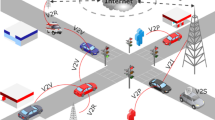Abstract
Mobility models must scale accordingly to the application and reflect real scenarios in which wireless devices are deployed. Typical examples of scenarios requiring precise mobility models are critical situations (e.g., vehicular traffic incident, escaping pedestrians in emergency situations) – for which the ad hoc paradigm was first designed for. In these particular situations, autonomous agents of communicating devices will assist mobile users in their displacements either to avoid traffic jam due to incidents or find the closest emergency exit. But, since the environment conditions (i.e., flow of pedestrians or vehicles and incidents) may change during time in part due to mobility itself, autonomous agents assisting mobile users in their displacements must constantly exchange information and dynamically adapt to the perceived situations. This requires to precisely modeling both mobility (vehicular and pedestrian traffic) and communications systems between agents. Unfortunately, these two areas have been treated separately, although mobility and network simulators should be tightly bound. In this paper, we propose a new modeling approach to mobility, namely Behavioral Mobility models (BM), which decomposes mobility into simple atomic individual behaviors. Combined, these behaviors yield realistic displacement patterns by reproducing the mobility observed at small scales in every day life, in both space and time. We also propose to bind mobility and network simulators to run joint simulations in order to push simulations to more realness. This approach combined to BM models is particularly suited to simulate critical situations where mobility is influenced by the changing environment conditions. We demonstrate the feasibility of our approach with two cases studies.
Access this chapter
Tax calculation will be finalised at checkout
Purchases are for personal use only
Preview
Unable to display preview. Download preview PDF.
Similar content being viewed by others
References
Camp, T., Boleng, J., Davies, V.: A Survey of Mobility Models for Ad Hoc Network Research. Wireless Communications and Mobile Computing 2(5), 483–502 (2002)
Johnson, D., Maltz, D.: Dynamic Source Routing in Ad Hoc Wireless Networks, vol. 353. Kluwer Academic Publishers, Dordrecht (1996)
Hong, X., Gerla, M., Pei, G., Chiang, C.: A Group Mobility Model for Ad Hoc Wireless Networks. In: Proc. ACM/IEEE MSWiM, Seattle, WA (August 1999)
Sanchez, M., Manzoni, P.: Anejos: A java-based simulator for ad-hoc networks. In: Future Generation Computer Systems magazine - Elsevier (March 2001)
Jardosh, A., Belding-Royer, E., Almeroth, K., Suri, S.: Real World Environment Models for Mobile Ad Hoc Networks. IEEE JSAC 23(3) (March 2005)
McNett, M., Voelker, G.: Access and Mobility of Wireless PDA Users. ACM Mobile Computing and Communications Review 9(2), 40–55 (2005)
Tuduce, C., Gross, T.: A Mobility Model Based on Wlan Traces and its Validation. In: Proc. IEEE INFOCOM, Miami, FL (March 2005)
Saha, A.K., Johnson, D.: Modeling Mobility for Vehicular Ad Hoc Networks. In: Proc. ACM VANET, Philadelphia, PA (July 2004)
Musolesi, M., Mascolo, C.: A Community based Mobility Model for Ad Hoc Network Research. In: Proc. ACM Realman, Florence, Italy (May 2006)
Ray, S., Feeley, M., Hutchinson, N., Cai, K.: Realistic mobility for mobile ad hoc network simulation (submitted for publication) (2006)
Kim, J., Bohacek, S.: A survey-based mobility model of people for simulation of urban mesh networks. In: MeshNets 2005, Budapest, Hungary (July 2005)
Kim, J., Ilic, A., Bohacek, S.: Realistic simulation of urban mesh networks - part I: Urban mobility. Technical Report, University of Delaware (2006)
Choffnes, D., Bustamante, F.: An integrated mobility and traffic model for vehicular wireless networks. In: Proc. ACM VANET, Cologne, Germany (September 2005)
Barr, R., Haas, Z., Renesse, R.V.: JiST: An efficient approach to simulation using virtual machines. IEEE Software Practice & Experience 35(6) (May 2005)
Helbing, D., Farkas, I., Vicsek, T.: Simulating Dynamical Features of Escape Panic. Nature 407, 487–490 (2000)
Yang, Q., Koutsopoulos, H.: A microscopic traffic simulator for evaluation of dynamic traffic management systems. Transportation Research C 4(3) (1996)
Reynolds, C.W.: Flocks, Herds and Schools: A Distributed Behavioral Model. In: Proc. ACM SIGGRAPH, Anaheim, CA (July 1987)
Balakirsky, S., Messina, E.: A simulation framework for evaluating mobile robots. In: PerMIS Workshop, Gaithersburg, MD (August 2002)
Henderson, L.: The Statistics of Crowd Fluids. Nature 229, 381–383 (1971)
The VINT Project. The Network simulator (Ns-2). [Online], Available: http://www.isi.edu/nsnam/ns/
Author information
Authors and Affiliations
Editor information
Editors and Affiliations
Rights and permissions
Copyright information
© 2006 Springer-Verlag Berlin Heidelberg
About this paper
Cite this paper
Legendre, F., Borrel, V., de Amorim, M.D., Fdida, S. (2006). Modeling Mobility with Behavioral Rules: The Case of Incident and Emergency Situations. In: Cho, K., Jacquet, P. (eds) Technologies for Advanced Heterogeneous Networks II. AINTEC 2006. Lecture Notes in Computer Science, vol 4311. Springer, Berlin, Heidelberg. https://doi.org/10.1007/11930181_14
Download citation
DOI: https://doi.org/10.1007/11930181_14
Publisher Name: Springer, Berlin, Heidelberg
Print ISBN: 978-3-540-49364-8
Online ISBN: 978-3-540-49365-5
eBook Packages: Computer ScienceComputer Science (R0)




